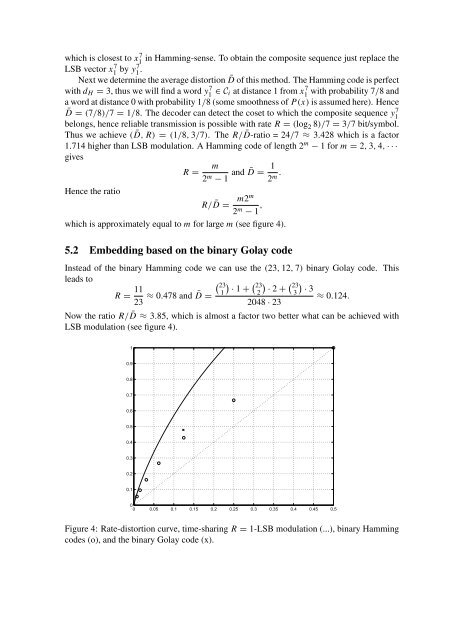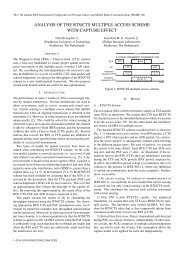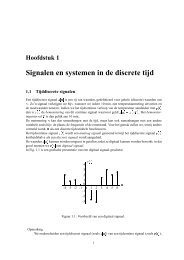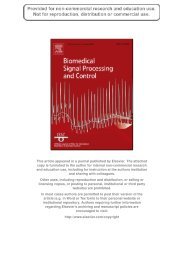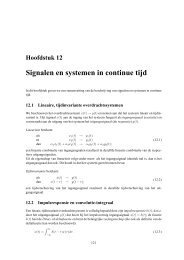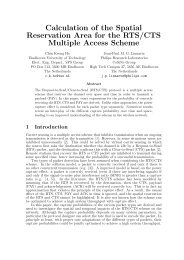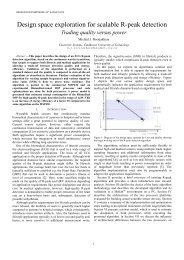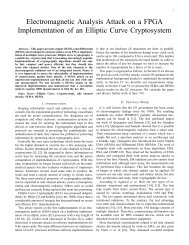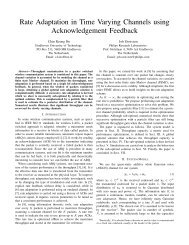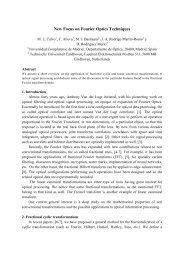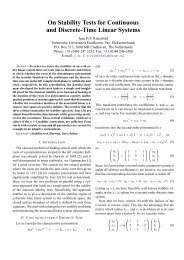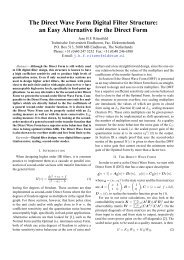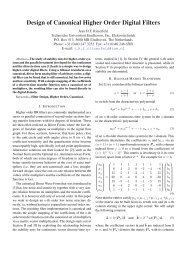Embedding Information in Grayscale Images - Signal Processing ...
Embedding Information in Grayscale Images - Signal Processing ...
Embedding Information in Grayscale Images - Signal Processing ...
You also want an ePaper? Increase the reach of your titles
YUMPU automatically turns print PDFs into web optimized ePapers that Google loves.
which is closest to x1 7 <strong>in</strong> Hamm<strong>in</strong>g-sense. To obta<strong>in</strong> the composite sequence just replace the<br />
LSB vector x1 7 by y7 1 .<br />
Next we determ<strong>in</strong>e the average distortion ¯D of this method. The Hamm<strong>in</strong>g code is perfect<br />
with d H = 3, thus we will f<strong>in</strong>d a word y1 7 ∈ C i at distance 1 from x1 7 with probability 7/8 and<br />
a word at distance 0 with probability 1/8 (some smoothness of P(x) is assumed here). Hence<br />
¯D = (7/8)/7 = 1/8. The decoder can detect the coset to which the composite sequence y1<br />
7<br />
belongs, hence reliable transmission is possible with rate R = (log 2 8)/7 = 3/7 bit/symbol.<br />
Thus we achieve ( ¯D, R) = (1/8, 3/7). The R/ ¯D-ratio = 24/7 ≈ 3.428 which is a factor<br />
1.714 higher than LSB modulation. A Hamm<strong>in</strong>g code of length 2 m − 1 for m = 2, 3, 4, · · ·<br />
gives<br />
R =<br />
m<br />
2 m − 1 and ¯D = 1<br />
2 m .<br />
Hence the ratio<br />
R/ ¯D = m2m<br />
2 m − 1 ,<br />
which is approximately equal to m for large m (see figure 4).<br />
5.2 <strong>Embedd<strong>in</strong>g</strong> based on the b<strong>in</strong>ary Golay code<br />
Instead of the b<strong>in</strong>ary Hamm<strong>in</strong>g code we can use the (23, 12, 7) b<strong>in</strong>ary Golay code. This<br />
leads to<br />
R = 11<br />
( 23<br />
) (<br />
23 ≈ 0.478 and 1 · 1 + 23<br />
) (<br />
2 · 2 + 23<br />
)<br />
3 · 3<br />
¯D =<br />
≈ 0.124.<br />
2048 · 23<br />
Now the ratio R/ ¯D ≈ 3.85, which is almost a factor two better what can be achieved with<br />
LSB modulation (see figure 4).<br />
1<br />
0.9<br />
0.8<br />
0.7<br />
0.6<br />
0.5<br />
0.4<br />
0.3<br />
0.2<br />
0.1<br />
0<br />
0 0.05 0.1 0.15 0.2 0.25 0.3 0.35 0.4 0.45 0.5<br />
Figure 4: Rate-distortion curve, time-shar<strong>in</strong>g R = 1-LSB modulation (...), b<strong>in</strong>ary Hamm<strong>in</strong>g<br />
codes (o), and the b<strong>in</strong>ary Golay code (x).


